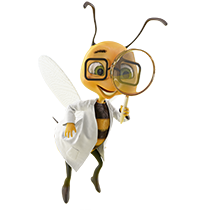Take out of the box:

sodium bicarbonate 2 g

stirrer 1 pc.

glass funnel 1 pc.

glass test tube 1 pc.

beaker 500 ml 1 pc.
Prepare at home:

550 ml water

spinach

large dish, e.g. a bowl
 FIRST AID INFORMATION
FIRST AID INFORMATION
In case of contact with the eye(s): wash out the affected eye with plenty of water, holding the eye open if necessary. Seek immediate medical advice.
If swallowed: wash out the mouth with water, drink some fresh water. Do not induce vomiting. Seek immediate medical advice.
In case of inhalation: remove person to fresh air.
In case of skin contact and burns: wash the affected area with plenty of water for at least 10 minutes.
If in doubt, seek medical advice without delay. Take the chemical and its container with you.
In case of injury always seek medical advice.
 ADVICE FOR SUPERVISING ADULT
ADVICE FOR SUPERVISING ADULT
Each SmartBee kit is intended for conducting experiments for children over 8 years of age. Because children’s abilities vary so much, even within age groups, supervising adults should exercise discretion as to which experiments are suitable and safe for their children.
Read and follow these instructions, the safety rules and the first aid information, and keep them for reference.
Be sure to thoroughly discuss the warnings and safety information with your child or children before commencing the experiments. Follow them and keep them for reference. Remember: misuse of chemicals can lead to injury or cause serious harm to health.
Carry out only those experiments that are listed in the instructions, using the equipment provided in the kit.
The area surrounding the experiment should be kept clear of any obstructions and away from the storage of food. It should be well lit and ventilated and close to a water supply.
A solid table with a heat resistant top is recommended for carrying out the experiments.
 SAFETY REGULATIONS
SAFETY REGULATIONS
Read these instructions before use, follow them, and keep them for reference.
Keep young children, animals and those not wearing eye protection away from the experimental area.
Always wear eye protection.
Store this experimental set out of reach of children under 8 years old.
Clean all equipment after use.
Make sure that all containers are fully closed and properly stored after use.
Ensure that all empty containers are disposed of properly.
Wash hands after carrying out experiments.
Do not store foodstuffs in any container which has held a reagent. Dispose of such containers immediately after use.
Do not use any equipment which has not been supplied with the set or recommended in the instructions for use.
Do not eat or drink in the experimental area.
Do not allow chemicals to come into contact with the eyes or mouth.
How do plants feed?
Plants adapted to produce their own nutrients in photosynthesis. During this process, organic compounds (glucose) and oxygen are produced from carbon dioxide and water with the help of solar energy. The organic compounds are food for the plants while the oxygen is released to the atmosphere. The pigment in leaves makes it possible to absorb solar energy and use it in photosynthesis.

Why would there be no life on Earth without plants?
See how photosynthesis works and learn how plants produce oxygen with the help of light.



Measure 500 ml of water in the beaker and pour it into the bowl.



Pour the entire contents of the sodium bicarbonate bottle.
You have just made a solution.
- Saturated solution - a solution in which you can’t dissolve more substances at a given temperature.
- Unsaturated solution - a solution in which you can still dissolve a certain amount of a given substance. In other words, this is a solution that is not saturated.



Put a few spinach leaves in the beaker. 5 leaves should be enough.



Place the glass funnel over the spinach - the wider end should be facing the beaker’s bottom.



Pour into the beaker leftover sodium bicarbonate solution. Don’t fill the funnel.
- Do you know that... medium-sized tree absorbs 5 kg CO2 from the atmosphere in a year. By comparison, a human is responsible for about 5 tons of carbon dioxide emission due to fossil fuels combustion. It means that to convert the CO2 made by one human, you need as many as 1000 trees!



Take the test tube and fill it with the resulting solution.



Without spilling the solution, place the test tube on the funnel.
- Do you know that... Some trees are purple?



Transfer the beaker to a sunny place and observe how bubbles appear on the spinach leaves!
- Attention! It can take a while. Observe carefully.



What just happened?
The bubbles on the spinach leaves and travelling to the top of the test tube are oxygen. Oxygen production from plants is a part of the photosynthesis process. It occurs in plant cells, which contain chlorophyll or bacteriochlorophyll. Sunlight is required for this process.
Photosynthesis
produces organic compounds from inorganic matter, takes places in cells containing chlorophyll or bacteriochlorophyll and involves light.
Chlorophyll
is an organic chemical compound with colouring properties present in plants, algae and bacteria conducting photosynthesis.
Chloroplasts
are cell organelles (specialised subunits) present in the green parts of plants.

Why is leaf green?
The most important pigment in plants is chlorophyll – it’s responsible for the green colour of leaves and stems. In autumn, when there’s less light, plants prepare for winter. During this time, transport of nutrients and chlorophyll production ceases. When there’s no chlorophyll in leaves, they change colour thanks to other pigments – carotene, xanthophyll and anthocyanin.
Carotenes and xanthophylls are responsible for the yellow, orange and red colour of plants (and for carrots’, pumpkin’s’ and tomato’s colouring as well) and they’re present in organs of plants throughout the year, though in a smaller amount than chlorophylls – that’s why you can hardly see their influence on leaves’ colour in spring and autumn. Anthocyanins make leaves change colour to brown. Pigments from this group dye plants in red, purple and blue. They are also responsible for the colouring of rose and hibiscus flowers. They’re also present in apples, plums, strawberries, red cabbage and cranberries.

What happens to the energy collected by a plant after its death?
Time for an observation!
Prepare the OBSERVATION SHEET. You will find it at the end of the instruction sheet. Like the proper scientists we are, we should now carry out observations.



Oxytree – what is it?
Oxytree is also often called the oxygen tree. It’s a cultivated variety of Paulownia, which grows very quickly regardless of climatic conditions. The annual growth of Oxytree reaches up to 3 meters, and after 6 years it already measures 16 meters. It has a broad umbrella-like crown and large leaves over 30 cm long. This tree stands out for producing 10 times more oxygen than other deciduous trees. It’s well suited for urban and roadside plantings and land reclamation. Its regenerative properties and high-quality wood mean that the cultivation of Oxytree can help protect forests from excessive logging.


Clean the stand and wash the accessories.
Where to dispose of the substances? Please follow your national regulations.